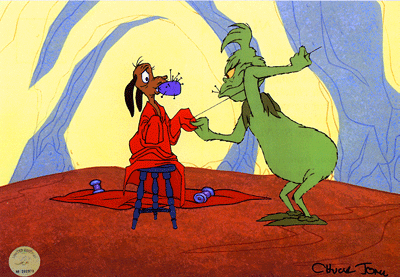

Schickel:
Since we have discussion leaders again for these sections, I won't go through them in great detail. Together, the two represent the "balance" of Schickel's positive and negative feelings about the Disney versions he's discussed throughout the book, so I'd like you to pay particular attention to how he balances out the good and bad. These chapters should also review for you the major issues of the book, so you might note what they are as you read.
Instead of questions, then, I want to give you a series of quotations from the text so that you can think about them before we discuss them in class on Thursday.
"If you have a child, you cannot escape a Disney character or story even if you loathe it. And, if you happen to like it, you cannot guide or participate in your child's discovery of its charms. The machine's voice is so pervasive and persuasive that it forces the child, then the parent, to pay it heed. In essence, Disney's machine was designed to shatter the two most valuable things about childhood--its secrets and its silences--thus forcing everyone to share the same formative dreams. It has placed a Mickey Mouse hat on every little developing personality in America. As capitalism, it is a work of genius; as culture, it is mostly a horror."
"'Mr. Disney, just what do you do?' 'Well,' I said, 'sometimes I think of myself as a little bee. I go from one area to another and gather pollen and sort of stimulate everybody.'" (Disney speaking about himself)
"A reporter once asked him . . . to name his most rewarding experience, and Disney's reply was blunt and brief: 'The whole damn thing. The fact that I was able to build and organization and hold it . . . ."
"The trick, of course, is to turn the interest stirred by the original idea into a habit that is beyond the reach of criticism narrowly conceived."
"It is the business of art to expand consciousness, while it is the business of mass communications to reduce it."
"The stars of a Disney movie are utterly interchangeable with others of their types. It was his name, and now, in his absence, it is the studio's name that draws the people."
"Many, many years
from now--decades, I hope--when this magical Pied Piper of our time wanders
from this imperfect world which he has done so much to brighten and adorn,
millions of laughing shouting little ghosts will follow in his train--the
children that you and I once were, so long ago, when first a gentle magician
showed us wonderland." (Max Rafferty)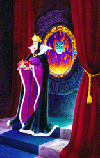
"He [Disney] shows scant respect for the integrity of the original creations of authors, manipulating and vulgarizing everything to his own ends. His treatment of folklore is without regard for its anthropological, spiritual or psychological truths. Every story is sacrificed to the 'gimmick.' The acerbity of Mary Poppins, unpredictable, full of wonder and mystery, becomes, with Mr. Disney's treatment, one great marshmallow covered cream-puff. He made a young tough of Peter Pan, and transformed Pinocchio into a slap-stick, sadistic revel!" (Frances Clarke Sayers)
"In a Disney book, what has vanished is motive and temperament, all the pulse of life under the skin of events, all the wild hope of someday understanding. Disney's world is not a child's world at all, for a child is a human reading for his future; it is an oldster's world, for an oldster is a human relaxing into his past." (Donald Barr)
"To see him [Disney] as merely the proprietor of a mouse factory is to miss entirely his significance as a primary force in the expression and formation of the American mass consciousness. When we seemed to demand an optimistic myth he gave us the unconquerable Mouse. When we seemed to demand the sense of continuity implicit in reminders of our past, he gave us fairy tales in a form we could easily accept. When we demanded neutral, objective factuality, he gave us the nature films. When, in a time of deep inner stress, we demanded another kind of unifying vision, he gave us a simplified and rosy-hued version of the small town and rural America that may have formed our institutions and our heritage, but no longer forms us as individuals. When we demanded, at last, not formal statements, but simply environments in which to lose ourselves, he gave us those in the amusement park built and the amusement parks yet to come."
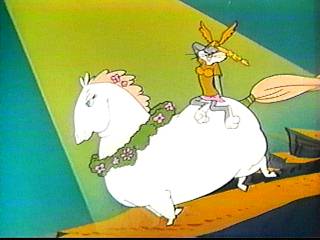 Klein:
Klein:
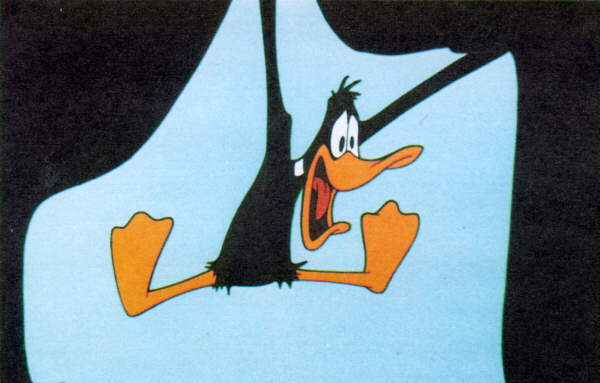
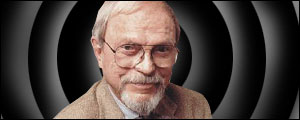 Chuck Jones--Extremes and Inbetweens: A Life in Animation
Chuck Jones--Extremes and Inbetweens: A Life in Animation
As you watch this week's video, I'd like you to try to get a sense of Jones as a filmmaker, and in doing that you should also focus on the following ideas::